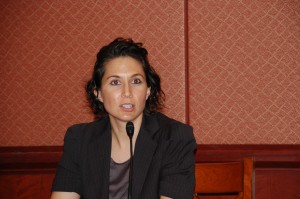By Paul R. Pace, News staff
A skilled and supported workforce is a critical component to drive better outcomes for children and families across the U.S., says Jenny Wood, chief deputy for the Administration on Children Youth and Families of the U.S. Department of Health and Human Services.
Wood was among the speakers at a Capitol Hill briefing in June called “Let’s Improve Child Welfare Outcomes: The Workforce Matters.”
The event, sponsored by the Child Welfare League of America and NASW, educated key policymakers and other stakeholders in Washington about the importance of a well-trained, educated and properly staffed workforce within child welfare. Wood noted the Administration on Children Youth and Families’ budget proposal, which President Obama unveiled this calendar year, has three primary proposals designed to invest more federal dollars for Title IV-E training to strengthen the nation’s child welfare workforce.
Given the research the agency has seen, Wood said, child welfare workers with BSW and MSW training serve as “a foundation and a bedrock to meet the needs of youth and families immediately upon hiring.” “We know enhancing the amount that we pay for BSW and MSW training is one way to help improve our federal workforce,” Wood said.
The chief deputy noted the agency is also launching a new quality improvement center that will test innovative programs and share best practices that can help ensure better retention rates and lower turnover rates in the workforce.
The Children’s Bureau also supports the National Child Welfare Workforce Institute (NCWWI.org). Participants at the briefing shared regional success stories in improving the child welfare workforce as well. Among them was Helen Cahalane, principal investigator of the Child Welfare Education and Research Programs and clinical associate professor at the University of Pittsburgh School of Social Work. Cahalane oversees the Pennsylvania Child Welfare Resource Center and two Title IV-E education programs, Child Welfare Education for Baccalaureates (CWEB) and Child Welfare Education for Leadership (CWEL).
“Our program supports Pennsylvania’s effort to retain child welfare professionals by providing an educational career ladder and assisting in the long-term career development of our workforce,” she said.
More than 25 years of research findings have highlighted several key areas that guide Pennsylvania’s investment in professional social work education in the child welfare workforce, Cahalane noted.
They include: Graduates of social work programs who specialize in child welfare are likely to remain in child welfare and experience greater job satisfaction. Social work graduates tend to stay in child welfare longer and come to the agency ready to do the job and make better decisions about child protection. Key attributes of an adequately prepared workforce include the ability to handle more complex caseloads, perform tasks more competently, effectiveness in developing permanency plans for children, and increased skill in engaging children and families.
Social worker Barry Chaffkin, CEO of Fostering Change for Children, also spoke at the event. He said the Children’s Corps program of Fostering Change for Children recruits college graduates who make a two-year commitment to working in New York City’s child welfare agencies in order to provide stability and continuity to the families they serve.
The program places 50 new workers each year. He noted the program focuses on recruitment and selection; pre-service training and on-going support to prepare and sustain high quality workers who have the potential to be leaders in the field. Almost 90 percent of the dropout rate in the child welfare workforce is attributed to lack of support and supervision, Chaffkin said. “We provide support,” he said. “We teach them how to stick it out… We do a lot of team building in how are you going to survive the system – all these things help.”
Chaffkin noted that many participants in Children’s Corps go on to pursue their MSW. Attendees also heard from Brandi Stocksdale, who was a Title IV-E education recipient for her BSW and then acquired her MSW from University of Maryland School of Social Work as part of a special grant focused on child welfare supervisors.
“When I graduated, I felt confident to enter the workforce,” she said of when she started in child protective services in Baltimore city. From there, Stocksdale moved on to become a field supervisor. As a supervisor, she said she observed that the Title IV-E participants were more prepared to do the work. “To stay in child welfare you have to have a sense of community with your colleagues, mentors in the field and leadership that is professional,” said Stocksdale, who is now a program manager with the Maryland Department of Human Resources/Social Services Administration.
“The (Title) IV-E program taught me the importance of building a strong workforce and creating that network of competent child welfare professionals who continue to serve children and families in Maryland,” she said. Angelo McClain, CEO of NASW, offered closing remarks at the briefing. He noted he started as a child neglect investigator in Texas.
“For me child welfare was the toughest job I ever loved,” he said. “I loved the mission. I loved the work.” He transitioned to frontline caseworker to frontline supervisor to middle manager to finally being the commissioner of child welfare in Massachusetts. He said his experiences have taught him that child welfare workers and social workers deserve respect, reimbursement and resources.
A way to reach those goals, McClain said, is passing a Social Workers Safety Act, similar to the bill that was passed in Massachusetts. “We need national social work safety,” McClain said. “That’s a way to respect people.” In addition, he added that social work salaries need to rise and lawmakers need to increase student loan forgiveness and educational leave programs. Concerning resources, he said social workers need good supervision, good mentoring, technology and opportunities to treat the secondary trauma they may experience.
“Ultimately we want a good, strong child protective services workforce so we can change the headlines,” said McClain. “We want to see a headline that reads, ‘America’s CPS system thrives after years of struggle.'”
More information about NASW’s efforts to improve the child welfare workforce can be found at: http://www.socialworkblog.org/advocacy/2016/02/president-obamas-budget-offers-opportunities-for-social-workers-in-child-welfare-behaviorial-health-early-childhood-home-visiting/ More information on NASW child welfare resources can be found at: http://www.socialworkers.org/practice/children/default.asp More information on Title IV-W can be found at http://www.socialworkpolicy.org/news/new-policy-brief-highlights-use-of-title-iv-e-funding-to-support-social-work-students.html




